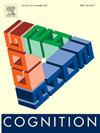突出的共享关联促进新型通信系统中的语义扩展
IF 2.8
1区 心理学
Q1 PSYCHOLOGY, EXPERIMENTAL
引用次数: 0
摘要
语义扩展的创造性过程在语言变化、语法化以及(根据假设)语言的早期起源和演变中起着关键作用。本文报道了两个二元交互实验,研究了受控环境下新标签的语义扩展。我们发现参与者可以在他们的感知环境中使用显著的和共享的关联(颜色和形状之间)来引导一个交流系统,然后可以通过利用与特定对象和情感相关的颜色等共同理解来形象地扩展这些标签,以传达具体和抽象的目标。通过在这一过程的早期操纵颜色和形状之间存在可靠的统计关联,我们表明这种共享关联促进了最初的语义扩展和随后的扩展链;我们还发现,依赖于不太确定的基础(例如,在颜色和情感之间)的扩展导致了扩展方式的更大变化。我们的方法可用于在受控条件下测试语义扩展的创造过程,并为联想与扩展之间的关系提供了以往仅通过相关方法研究的实验支持。本文章由计算机程序翻译,如有差异,请以英文原文为准。
Semantic extension in a novel communication system is facilitated by salient shared associations
Creative processes of semantic extension play a key role in language change, grammaticalisation, and (by hypothesis) the early origins and evolution of language. In this paper we report two dyadic interaction experiments studying the semantic extension of novel labels in controlled circumstances. We find that participants can use salient and shared associations in their perceptual environment (between colours and shapes) to bootstrap a communication system, and can then extend those labels figuratively, to convey both concrete and abstract targets, by exploiting shared understandings such as colours associated stereotypically with specific objects and emotions. By manipulating the presence of reliable statistical associations between colour and shape early in this process we show that such shared associations facilitate both an initial semantic extension and subsequent chaining of extensions; we also find that extensions relying on less certain grounding (e.g. between colours and emotions) lead to greater variability in how extensions are made. Our method can be used to test the creative processes of semantic extension under controlled conditions, and provides experimental purchase on the relationship between association and extension which have only previously been studied through correlational means.
求助全文
通过发布文献求助,成功后即可免费获取论文全文。
去求助
来源期刊

Cognition
PSYCHOLOGY, EXPERIMENTAL-
CiteScore
6.40
自引率
5.90%
发文量
283
期刊介绍:
Cognition is an international journal that publishes theoretical and experimental papers on the study of the mind. It covers a wide variety of subjects concerning all the different aspects of cognition, ranging from biological and experimental studies to formal analysis. Contributions from the fields of psychology, neuroscience, linguistics, computer science, mathematics, ethology and philosophy are welcome in this journal provided that they have some bearing on the functioning of the mind. In addition, the journal serves as a forum for discussion of social and political aspects of cognitive science.
 求助内容:
求助内容: 应助结果提醒方式:
应助结果提醒方式:


